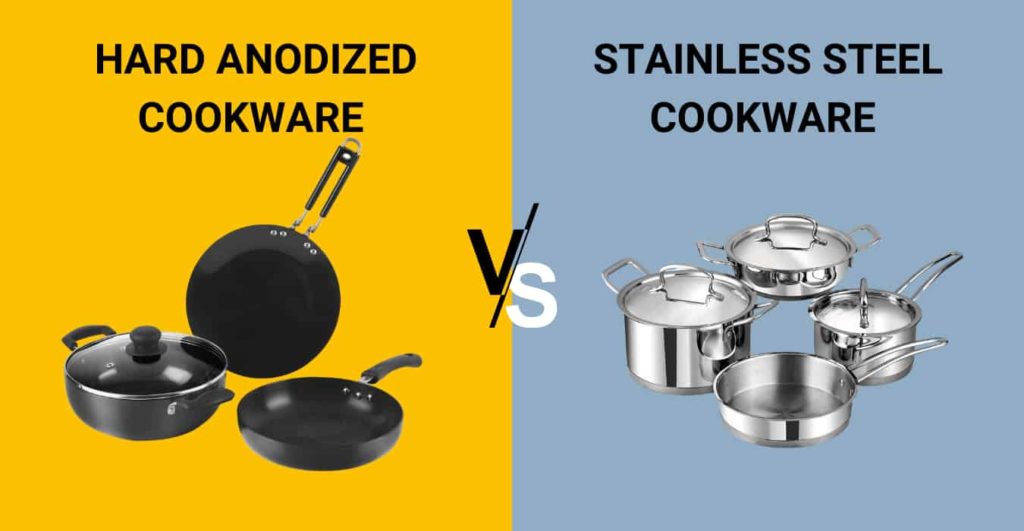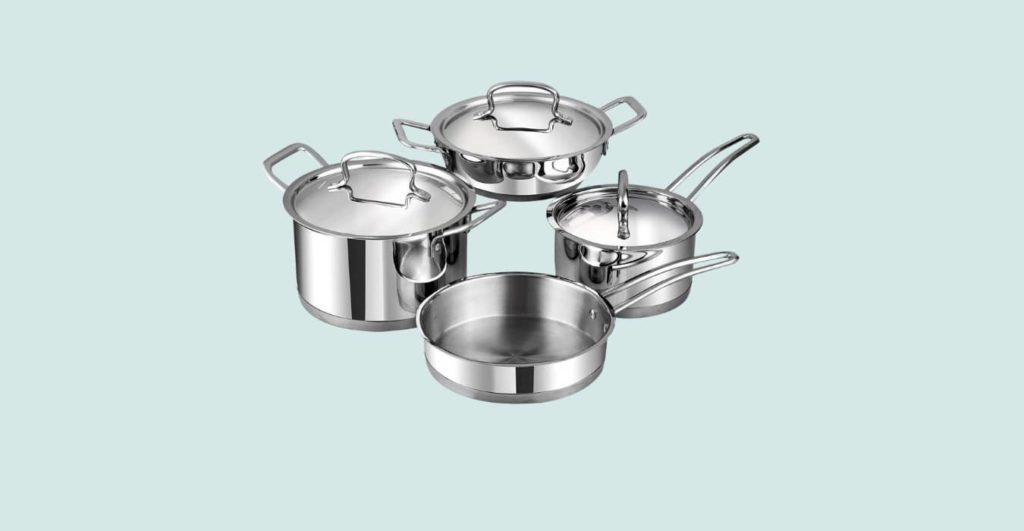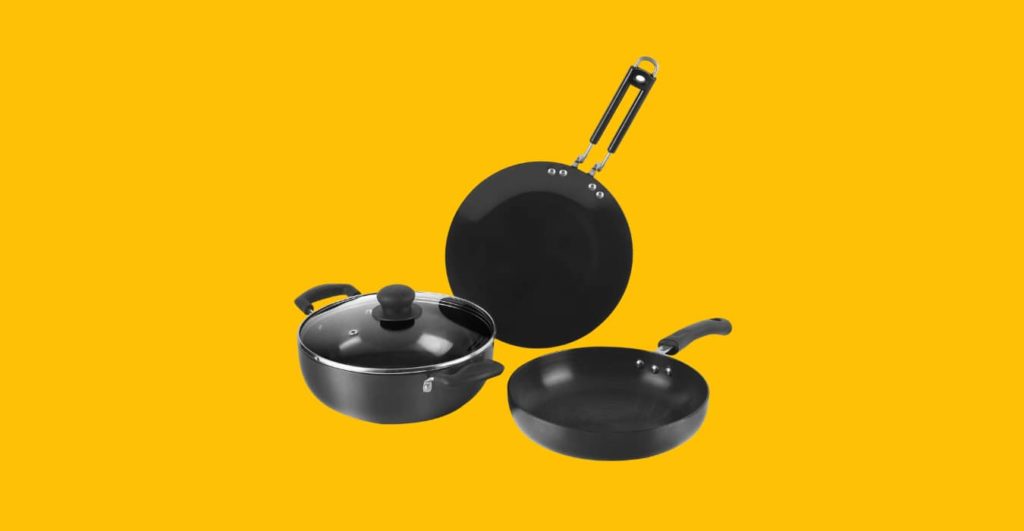Hard Anodized Vs Stainless Steel Cookware needs a closer look to be able to purchase the right product. While both the cookware are relevant and popular with their own set of takers, a better understanding of each of these will allow the user to know their purpose. So, how is Stainless steel different from Anodized cookware? Let us find out more about each of these to know them better:


We have all grown with the Stainless steel cookware being a major part of our kitchen and mealtimes. These are popular due to their durability and continue to remain a vital part of our lifestyle, sometimes for generations. But what is stainless steel cookware all about, and how has it remained important all this while? Let us find out:
The Main Features
To better understand the difference between hard anodized and stainless steel cookware, it is necessary to take a look at the features.
- The stainless steel cookware’s surface is scratch-resistant, hence making it one of the most popular cookware for families with children.
- Stainless steel cookware has a shiny surface; hence it gives a nice appearance to it, making it worth the display.
- This is perhaps one of the most versatile metals out there. The stainless steel cookware can be used on the stovetop or even oven, as long as the temperature is maintained well below 500F. There is also a certain stainless steel cookware range that is Induction-proof.
How Stainless Steel Cookware Made?
To know what is the difference between hard anodized and stainless steel cookware, it is important to understand their construction. There are various versions of the stainless steel construction, which include the ‘fully-clad’ and the ‘Impact-bond’.
Fully Clad Stainless Steel Cookware: This involves various pieces of metals that are bonded together to make a ‘ply-like’ arrangement. This refers to the number of layers bonded together to construct the stainless steel cookware. The term ‘fully-clad’ means that the conductive layer is seamlessly bonded throughout.
The Impact-Bond Stainless Steel Cookware: This is the variation that is made of a Conductive metal at the base as opposed to the upper side in the regular construction. These are also the budget-friendly type.
However, the number of plys is far less relevant compared to the way the metal is bonded. Hence, when shopping for the Stainless steel collection, be sure to check out the thickness rather than asking about the Ply-count.
How Does Stainless Steel Cookware Look?
As mentioned earlier, Stainless steel cookware is all about shiny surfaces and sleek appearance. But beneath the polished exterior is a Silvery interior which adds to its value as well. Some of the latest in the Silver cookware collection comprises the ‘cook and serve’ functionality that makes it possible for the individual to be able to place their cookware for a beautiful meal spread.
The other more popular trend in the Stainless steel collection is the ‘Brushed-Finish’. This involves a sand-like appearance and has been polished with a non-abrasive pad to offer the ‘matt’ or the dull look. Even though the ‘Polished’ is the more traditional and common look, it is the ‘Dull’ that has been gaining popularity recently.
The Advantages of Stainless Steel Cookware
Let us take a look at some of the advantages of stainless steel cookware:
- These are Polished and Shiny and are good to look at.
- The Stainless steel cookware is also durable, hence making them a go-to for most Indian homes with small children.
- Being Versatile, the Stainless steel cookware can be used in various cooking conditions, like a stovetop, oven, or induction.
- The stainless steel products are also resistant to rust and corrosion.
The Disadvantages of the Stainless Steel Cookware
- Let us take a look at some of the disadvantages of Stainless Steel cookware:
- These come with a price tag; hence are expensive in comparison.
- Can get smudged easily when placed outside.
- Are not exactly the ‘elegant’ dining ware option. Hence not for your fine-dining dinner or party.
The Hard Anodized Cookware

When it comes to the stainless steel cookware vs hard anodized, the latter is the new kid in the block. Being easier to use and much less expensive in comparison, this is a much-preferred cookware option. Also, it is vouched to be the most versatile in comparison to the other options.
How Hard Anodized Cookware Made?
Let us take a look at how the Hard Anodized Cookware is constructed. Interestingly, this new-age cookware metal is constructed by subjecting the Aluminum base to an Electromagnetic process. This causes the metal to harden up and also strengthen up along the process. Hence, the hard Anodized metal offers the required durability one expects quality cookware to offer with time.
While this was a unique trend a few decades ago nevertheless, the cookware today comprises a non-stick coating to offer versatility. This is the reason why most modern cookware is ‘non-stick’ in nature and can be used for various purposes. Also, the hard Anodized cookware has good conductive properties; hence, there is even heat distribution all over the cooking surface. Being non-stick in nature, it is also easy to be cleaned.
How Does Hard Anodized Cookware Look?
Appearance-wise, the hard Anodized cookware has a dark grey exterior and a Black or Charcoal cooking surface. But, the more trendy collection is painted in fun colours to offer a vibrant appearance. This makes this cookware type one of the most popular picks for a bright interior.
The Advantages Of Hard Anodized Cookware
Let us take a look at some of the advantages of Anodized cookware:
- These are quite durable, hence can be used daily for kitchen and cooking purposes.
- The Hard Anodized cookware is also scratch and dent-resistant. Thus, these can be placed and used for various purposes without worrying about breakage.
- These are the original ‘non-stick’ cookware hence can be used for various cooking options. The process of cooking is convenient and more even throughout the surface.
- Being a good conductor of heat, the cooking time is greatly reduced in the case of the Hard Anodised Cookware.
- The Anodised cookware is also easy to clean and maintain, as the surface is non-stick, hence, making it easy on the hands.
The Disadvantages of Hard Anodized Cookware
Let us examine some of the disadvantages of the Anodised cookware:
- These are expensive. The Anodized cookware arrives with a heavy price tag due to its various qualities.
- Being good conductors, these get heated up quite quickly and can pose a threat to the user by being more prone to causing burns.
- These are not dish-wash-friendly. Hence, you will have to clean them up manually.
Hard-Anodized Vs Stainless Steel Cookwarer-FAQs
When it comes to versatility and tradition, it is the Stainless steel cookware of all time.
They are safe. However, being highly conductive can threaten burns for the user.
The Stainless steel cookware does not comprise any coating; hence, these are healthier of the options.
Hard-Anodized Vs Stainless Steel Cookware: The Conclusion
So, my dear ladies, here you have it, all that there is to know about the difference between Stainless steel and Anodized cookware. Still confused? Allow us to help you out:
The Tradition: Stainless steel cookware has been a vital part of our lifestyle from the start. Hence these can be used and passed on to generations if maintained well and owing to their durability.
The Fun Factor: Like colours? Well, go for the Hard-Anodized cookware if you like some amount of vibrancy in your kitchen. These are available in various fun patterns, colours, and more. Also, being non-stick type, these are easy to clean and maintain.